Allow me a tortured metaphor. Say that the entire LGBT community has gathered in a hall somewhere. They’ve all gathered for a nice vegan dinner, and the tables are laid out. Unfortunately for this gathering of the entire LGBT community, a large elephant has joined them. The elephant knocks over tables, eats all the lesbians dinner, and poops in the kitchen. Everyone at the gathering steadfastly ignores the elephant, despite the fact it is destroying the gathering. Eventually, one of the lesbians stands up, and complains about the elephant. The rest shout her down, kick her out of the gathering, and label her ‘elephant exclusionary’.
Gradually, the gathering and the hall is destroyed. The lesbians, kicked out in ever greater numbers for being ‘elephant exclusionary’, start making tofu in a bonfire outside. The gay men are still denying the elephant is even there as it repeatedly throws chairs at them. The elephant is smacking the bisexuals with a frying pan, and the transsexuals have been trampled. Everyone in the gathering is still trying to ignore the elephant.
Truly a tortured metaphor, but let’s give the elephant a name.
That name is ‘autogynephilia’.
I can hear you now, ‘auto-whata-philia?’. The word is difficult to get your mouth around. It is also a verboten word. People whisper it in dark alleys level verboten. Like ‘Voldemort’ in Harry Potter. The Elephant That Must Not Be Named. If you say it out loud, someone will arrive at your door and brand the four scarlet letters of the LGBT community on your forehead — you’ll be a ‘TERF’. I guarantee it. Even I avoided saying the word in my original article, Inauthentic Selves, which had a section on autogynephilia end up on the cutting room floor, because I wanted the broader LGBT community to be able to read about the way that LGBT activism has been astroturfed.
But I bet you’re thinking ‘I’ve never heard of these autoawhataphias’.
Are you a member of the LGBT community? If you are, surely you know a male to female transitioner. They are in their late thirties to their early fifties, they call themselves a ‘lesbian’, and they wear clothing that’s inappropriate for their age. They’re ex-cop, military, or most often, work in something involving computers.
I can see your head nodding behind the screen. Congratulations, you’ve seen autogynephilia.
But what is autogynephilia? What is the elephant? How is it relevant to the LGBT community? And why is no one pointing it out?
Firstly, we have to describe sexologist Dr. Ray Blanchard’s transsexualism typology, and what it means. Blanchard states that there are two causes (or etiologies), of transsexualism in males: homosexual transsexualism, and autogynephilia. Homosexual transsexualism is what you think it is — exclusively homosexual males who are very effeminate, experience gender dysphoria because of this, and transition to alleviate their dysphoria. Traditionally, these homosexual males are given ‘third gender’ roles in society : the vast majority of ‘third genders’ or ‘third sexes’ that have been observed across a huge variety cultures are a way to classify these homosexual males in a patriarchal society and make them sexually available for ‘heteroseuxal’ men. The second cause is our elephant: Autogynephilia, a term coined by Blanchard in the mid-80s.
The term itself means ‘love of oneself as a woman’, and the term is used to describe a phenomenon that Blanchard noticed during his research on transsexuals. In his original 1989 paper, Blanchard described ‘autogynephilia’:
“Gender identity disturbance in males is always accompanied by one of two erotic anomalies. All gender dysphoric males who are not sexually oriented toward men are instead sexually oriented toward the thought or image of themselves as women. The latter erotic (or amatory) propensity is, of course, the phenomenon labeled by Hirschfeld as automonosexualism. Because of the inconsistent history of this term, however, and its nondescriptive derivation, the writer would prefer to replace it with the term autogynephilia (“love of oneself as a woman”). It should be noted that the concept of autogynephilia does not imply that autogynephilic males are always sexually aroused by the thought of themselves as women, or by dressing in women’s clothes, or by contemplating themselves cross-dressed in the mirror- any more than a man in love always obtains an erection at the sight of his sweetheart, or pair-bonded geese copulate continuously.”
Blanchard describes autogynephilia as both a paraphilia and a sexual orientation, where the autogynephilic male is orientated inwards to a fantasy female self. This fantasy can be of several types, such as anatomic autogynephilia, fetishizing female physiology, behavioral autogynephilia, fetishizing ‘feminine behavior’, and transvestic autogynephilia, fetishizing female clothing. Most autogynephiles are of more than one type. He also notes in the paper that this is a paraphilia that has been recorded since at least the 19th century. Blanchard also comments on a phenomenon that has become apparent on websites like Tumblr, of teenage girls reading erotic literature about gay men termed ‘yaoi’ (literature which is aimed at women, not gay men) and then identifying as ‘gay trans men’, mentioning a case history that was rather similar:
“ Lothstein reported a case history collected by one of his colleagues. The patient was a 17-year-old female who viewed herself as a homosexual male. She expressed the wish to become a male ballet dancer and then to have “homosexual” relationships with other men. The patient recalled that her first wishes for surgical sex reassignment occurred after she encountered some homosexual erotic literature describing sex between males. The patient was averse to her female genitals and expressed the notion that she would, as a homosexual male, prefer to be penetrated anally”
Possibly the best resource on autogynephilia is Anne A. Lawrence’sMen Trapped In Men’s Bodies. Lawrence, who admits her autogynephilia and transitioned in the mid 90s, describes multiple case histories and the science behind autogynephilia in detail. Lawrence agrees with the Blanchard typology:
“ I would simply like to state for the record that, based on my clinical experience and my reading of the scientific literature, I am firmly convinced that the overwhelming majority — probably 98% or more — of cases of severe gender dysphoria in men arise in connection with either effeminate homosexuality or autogynephilia; most of the rare exceptions probably arise in connection with conditions such as schizophrenia and certain personality disorders. The idea that substantial numbers of MtF transsexuals belong to a putative “third type” that is neither homosexual nor autogynephilic is inconsistent with my clinical experience and is, in my opinion, inconsistent with the best available empirical evidence”
Lawrence also describes that autogynephiles in clinical studies frequently lie about the sexual arousal they associate with cross-dressing and their sexual fantasies of being a woman, and many lie about being homosexual in order to obtain sexual reassignment services.
From reading Lawrence’s case histories, it is clear autogynephilia is also something you wouldn’t wish on anyone. The men featured often have difficulty relating to sexual partners, finding the autogynephilic fantasy all-consuming, some to the point they feel no external desire at all:
“ Many informants reported that they usually or invariably engaged in cross-gender fantasies when they had sex with female partners; some stated that heterosexual performance was possible only when they utilized such fantasies. Several informants observed, however, that obligatory reliance on autogynephilic fantasies seemed to diminish or preclude genuine intimacy. In some instances, autogynephilic arousal overshadowed or displaced heterosexual attraction and behavior almost completely: Informants were aroused by the fantasy or reality of themselves as female, but they reported little or no attraction to potential female sexual partners”
The autogynephilic desire competes with the heterosexual one. Reading some of Lawrence’s case histories are quite depressing.
“ One informant observed that her obligatory reliance on autogynephilic imagery for sexual arousal precluded genuine intimacy during partnered sex and sometimes made her feel awful:
I can’t remember a time when I was able to have an orgasm without fantasizing myself as a woman. Whether I was making love to a woman or pleasing myself, nothing could happen for me without an accompanying fantasy that I was a woman. My own pleasure is all but guaranteed, as long as I can conjure up the right fantasy. But there’s also a dark side: There is almost no way for me to have intimate and loving sex. The simple act of giving to my partner is turned topsy-turvy by my need to imagine myself as her. At rare times it works out, and both of us are happy. More often I end up feeling really awful. And sometimes my need for this fantasy leaves me feeling like some kind of bizarre emotional vampire. Then sex becomes a chore, even a threat, to me; it’s no fun any more, and it stops happening.”
“ Why would consistently resorting to autogynephilic fantasies during sexual intercourse make one feel like an “emotional vampire”? Perhaps because vampires take something they require from their victims without giving anything back (or at least anything good). Nearly everyone needs and wants emotional intimacy during sex, but habitually resorting to autogynephilic fantasies can make autogynephilic men feel that they are receiving such intimacy without giving any back to their partners.
Money (1988) graphically described this absence of reciprocated intimacy:
One paraphilic patient equated intercourse with his wife with masturbating in her vagina. In his paraphilic fantasy, she was a stage property, not a participant actor.
It is easy to imagine why partnered sex might feel really awful and eventually stop happening if one’s partner is merely a prop.
Many autogynephiles find that their autogynephilia eventually leads to divorce. Their wives are often maligned online, despite the heartbreak and pain many of them go through.
“ One informant reported that his wife seemed to regard him as an alien being who had somehow taken possession of her husband’s body:
The feeling of my growing breasts and softening skin is more sexy to me than anything or anyone outside myself. My wife sees me as a totally selfish person, one who has killed and inhabited her husband’s body and is ruining what is left of him. (073)
In my practice, I have more than once heard reports of spouses invoking images of alien or demonic possession to describe the powerful forces that seem to have taken control of their husbands’ bodies and lives.
It’s also clear that issues like the ‘bathroom bill’ might be sexually motivated:
“ Others were sexually excited by the idea of being with other women in a gym or locker room and feeling as though they genuinely belonged or deserved to be there. Here are two representative examples:
“I started hormones about 6 months ago and am awaiting approval for sex reassignment surgery. The most sexually exciting thing about being a woman is fitting in as a woman and finally feeling I have a place to belong. I often fantasize being postoperative and being able to go to the gym and finally being able to shower with other women after having a nice workout. I am really turned on by the idea of going into the women’s shower and being surrounded by femaleness and of just being able to legally belong in the women’s restroom. What I’m saying is that to truly fit in as another woman in these places means a great deal sexually to me. ”
After reading about autogynephilia, I think that I have come a long way in understanding myself and my motivations and desires. Most of my early masturbatory fantasies involved being transformed into a woman and living as a woman. I don’t really care about the clothes. It is about being able to see myself as a woman or at least with feminine qualities. My most enjoyable moments are imagining experiencing the more tame parts of life as a woman (e.g., playing golf, going to the women’s room or locker room, being able to shop for feminine clothes and shoes, and being seen as a woman.) The few times I have been in a women’s locker room have been overwhelming. The smell is so inspiring and alluring and the idea of being able to go there and be accepted as a woman — I certainly can understand why people go completely through the surgery”
It is important to emphasize that the narratives that mentioned wanting to be with other women in a gym or locker room never carried overtly voyeuristic overtones. What was arousing to the informants was being accepted as a woman by other women, not the opportunity to view nude or scantily clothed female bodies. In fact, one informant explained that experiencing the absence of male-typical feelings was what made the locker room scenario arousing:
I am deeply aroused by the idea of being in a locker room with other women and having no male sexual feelings.
Lawrence also records case histories of autogynephiles viewing lesbians as props to fulfill the sexual fantasy:
“ I’m a 50-year-old MtF transsexual, in transition about 10 years. I fit into the behavioral autogynephilic pattern. I am currently and always have been attracted to females. My conscious memory of gender dysphoria really began at age 13 with dressing up, which was always connected with sexual arousal and orgasm. This early fantasy was of being a girl and being with a girl. I had a real interest in reading lesbian love story paperbacks, which aroused me. I started to go out with girls at age 15 or 16. From 16 on up, I never really had any great desire to have intercourse, but I was really interested in a lesbian relationship, usually with a clothes fantasy. My sex life with my girlfriend from ages 16 to 18 was what I fantasized as a lesbian relationship. We never had intercourse: She was trying to be moral and I had no real interest in intercourse.”
Even changing gender markers on a drivers license aroused some of the autogynephiles who talked with Lawrence:
“ I will confess that officially changing my name and changing my driver’s license and ID over to “female” did sexually excite me, as I felt I had pushed myself to a point of no return. The notion of now being trapped in my new gender reminded me of all of the little pink storybooks of “forced transitions” I had bought and been stimulated by earlier.”
The current trend in the community, of course, is to deny autogynephilia exists or that it could possibly be a motivation behind current transgender ideology. Lawrence even talks about it in her book:
“ It is easy to find examples of such invalidating assessments on many of the Internet sites maintained by high-pro file MtF transsexual activists. These individuals often state or imply that autogynephilic transsexuals are not genuinely or legitimately transsexual. Ironically, the transsexual activists who maintain these Internet sites often have demographic profiles that are strongly suggestive of autogynephilic transsexualism, although the activists usually deny or minimize any history of autogynephilic arousal”
Google ‘autogynephilia’, and you find plenty of people game to try and ‘debunk’ it, including Lawrence’s activists.
Of course, it is not difficult to find evidence of autogynephilia in action on transgender message boards. A radical feminist subreddit, called ‘r/itsafetish’, specifically tracks these message boards and posts examples of autogynephilia for all to see, including on the most popular transgender message boards on Reddit, including ‘r/asktransgender’. Here is a sample for you:
(All credit to the contributors on r/itsafetish)
The fact that these stories and comments heavily resemble case histories in Men Trapped In Men’s Bodies seems to pass these posters by, as they insist their obvious autogynephilia is really ‘gender euphoria’, despite the fact their descriptions of gender dysphoria and transgenderism would slot neatly into Lawrence’s case histories.
Denying autogynephilia is a problem. Not just for these men, but also for the LGBT community.
Now that you know what the elephant is, what’s the problem?
The Problem With The Elephant
For autogynephiles, the LGBT community is viewed as a prop to achieve a sexual fantasy. The community is a means to an end — the end being getting off and living out their sexual fantasies.
This is particularly relevant to lesbians, who have been the most affected by the invasion of autogynephiles in the LGBT community. The current discourse in the LGBT community tells lesbians that male genitalia are, in fact included in lesbian sexuality, despite that being contrary to both common sense and the dictionary definition of lesbian, which is, in fact, ‘female homosexual’.
Why tell lesbians that male genitalia are included in lesbian sexuality, with the threat of exile and harassment if they call that out as horseshit?
Lesbians — women who will only have sex with other women — are viewed as the ultimate validatory prop in the autogynephile sexual fantasy. If a lesbian sleeps with an autogynephile (as unlikely as that is), it validates the autogynephile’s sexual fantasy of being a woman. If an autogynephile is called a ‘lesbian’ and validated as a ‘lesbian’, that is also a component of the sexual fantasy and a validation of the internal female self. Somehow, that’s more revolting than any form of homophobic motivation. Lesbians aren’t seen as people, but as props to further an internal sexual fantasy.
To justify this without referencing the autogynephilia, they use a very warped form of trans rights activism and transgender ideology to warp sexuality to be about ‘gender identity’ rather than sex. This is so autogynephiles can insert themselves into lesbian sexuality. Now that sexuality is about ‘gender identity’ rather than sex, the exclusively same-sex attracted lesbian, who desires only other female bodies, is now a transphobic bigot, because she’s discriminating against the autogynephiles ‘gender identity’ in denying them sex because they have male bodies. This also applies to gay men — if they say no to trans gay men, i.e females with vagina, they too are transphobic bigots discriminating against the gender identities of trans gay men. Gays and lesbians who are exclusively attracted to the same sex are ‘exclusionary’ and ‘gatekeeping’.
There is plenty of evidence of this occurring online. The website TERF IS A SLURdocuments this under the heading ‘Cotton Ceiling’. Here is an extract of some of the evidence:
The term ‘cotton ceiling’ even has a Wikipedia page, which, I kid you not, features a picture describing the different kinds of ‘women’s cotton panties’. It defines the ‘cotton ceiling’ as following:
“The term cotton ceiling refers to the difficulty trans people experience when seeking lesbian and gay relationships, and in lesbian and gay social spaces more generally. The term was coined by Canadian trans woman and activist Drew DeVeaux. A play on the similar term “glass ceiling”, the “cotton” refers to trans women’s underwear as an example of how their perceived genitalia prevents them from being recognized as women.”
Of course, despite their sexual fantasies, lesbians have been rather non-compliant. There are entire articles about the ‘discrimination’ that trans women face in lesbian communities. Seriously, look at this whinging from prominent trans activist Julia Serano:
“this not a minor problem — it is systemic; it is a predominant sentiment in queer women’s communities. And when the overwhelming majority of cis dykes date and fuck cis women, but are not open to, or are even turned off by, the idea of dating or fucking trans women, how is that not transphobic? And to those cis women who claim a dyke identity, yet consider trans men, but not trans women, to be a part of your dating pool, let me ask you this: How are you not a hypocrite?
I did not write this piece to vent about my dating life. I go out on plenty of dates, and I’m having lots of super-fucking-awesome sex, just not with cis women at the moment. My purpose in writing this piece is to highlight how cis dykes’ unwillingness to consider trans women as legitimate partners translates directly into a lack of community for queer-identified trans women. After all, queer women’s communities serve several purposes”
I’m sorry lesbians aren’t into your dick, buddy, but that’s kind of the meaning of ‘lesbian’.
The obsession with being seen as a woman, and access to lesbian spaces and lesbian sexuality is easily explainable when we introduce autogynephilia into the mix. Being seen as a ‘lesbian’ and part of the ‘lesbian community’ is a part of the sexual fantasy. It is also fundamentally selfish. Lesbians have lost spaces, bars, even websites. Lesbian spaces, which are sources of validation and provide the fulfillment of a sexual fantasy for autogynephiles, have been almost completely colonized. Even their very sexuality is colonized. Autostraddle, a website that promotes itself as a ‘girl on girl culture website’, published an article written by an autogynephile titled ‘How to Have Lesbian Sex With a Trans Woman’. It opens with this:
“Some lesbian, bisexual and queer women have penises. Trans women come all sorts of ways, and some of us haven’t had surgery yet or don’t want to. Also some trans women are queer! The conversation about trans lesbian sex often focuses on anal, or on using the non-trans partner’s genitals — but that’s not all there is. Trans lesbians and their partners can have sex in so many fun ways that do involve their penis and testicles, but don’t necessarily trigger dysphoria. There’s a lot of fun you can have, and while sex between someone with a penis and someone with a vagina is the norm of what we’re presented in society, not many of those tips deal with the fact that maybe one of those people is a woman. So I’m here to help you have the best girl-on-girl sex you’ve ever had as or with a trans woman.
These tips focus on sex with hands and mouths, since personally PIV sex is much harder on my dysphoria. And I know that not all trans women have penises, and that queer women can have sex with people with penises who aren’t trans women, but here I’ll be referring to women (trans or cis) having non-PIV sex with a trans women with a penis.”
Yes, it is indeed an article saying that sex that involves a person with a penis and a person with a vagina can indeed be homosexual sex if you change the labels around. My brain hurts. This badgering of gays and lesbians is also on YouTube, such as in this particularly putrid video which I am told is quite (in)famous, by a Riley J. Dennis (which one of us in the research group amusingly termed ‘Riley J. Penis). The badgering has even expanded to include telling straight men to ‘work through’ their lack of attraction to penis.
To say ‘lesbians don’t like penis’ is now an easy way to commit social suicide in the LGBT community. Because that might involve pointing out the elephant in the room.
That this is a community wide issue is not often discussed, and it might have something to do with money and the current state of LGBT non-profit and advocacy organizations. Jennifer Pritzker, who donates plenty of money to trans rights, including the transitioning of children, fits the pattern of a late-transitioning autogynephile almost perfectly, right down to being ex-military. Major non-profits and Pride organizations have plenty of them claiming to be ‘lesbian representation’ on their boards. The hijacking of LGBT organizations is so complete that lesbians who march with a sign saying ‘lesbian = female homosexual’ in the Pride Parade are called ‘trans exclusionary radical feminists’. Seriously, that’s all the signs said.
“To understand this reversal, you need to understand why these women were protesting in the first place, and how their message slams headlong into the most intractable divide in today’s LGBT movement. The group, which calls itself Get the L Out, carried banners proclaiming “lesbian not queer”, “lesbian = female homosexual” and “transactivism erases lesbians”. For Stonewall, which has made trans inclusion a central part of its renewed mission since Hunt took over in 2014, this was beyond the pale. Stonewall’s position can be summed up in one of its popular T-shirt slogans: “Some people are trans. Get over it.” Get the L Out was resolutely failing to get over it.
These exclusionary lesbians who dare to not be attracted to male bodies, despite that being an essential trait of lesbianism, are then called ‘TERFs’ and relentlessly mischaracterized.
Gay men are also beginning to face colonization of their spaces, such as this example of a female to male identifying transgender person using a gay bathhouse.
But before the lesbians and the gays, the autogynephiles had to colonize another group first — homosexual transsexuals. Organizations like the National Center for Transgender Equality were founded by Mara Keisling, who transitioned in their early 40s and fits the autogynephile profile. The vast majority of organizations for ‘transgender people’ are run by and for autogynephiles, who use homosexual transsexuals as political props but do not meaningfully include them. The very different struggles, and needs, as well as demographics of homosexual transsexuals are completely erased.
Now, major gay and lesbian non profits have also been colonized. That is likely why organizations like the Human Rights Campaign now define ‘gay’ as ‘ A person who is emotionally, romantically or sexually attracted to members of the same gender.’ and don’t even bother to define the word ‘homosexual’ in their glossaries. That might be a problem.
That the colonization of the LGBT community by autogynephiles has coincided with the popularization of the word ‘queer’ is no coincidence. Perhaps it even explains the popularity of the word. ‘Queer’ is beginning to be used as dumping ground for societies ‘sexual deviants’, with some pushing for ‘kink’ to be included under the ‘queer umbrella’. It has even begun to include ‘queer heterosexuality’ (no, really), which even has a Wikipedia article defining it is as the following:
“Queer heterosexuality is said to be demonstrated when one or both hetero partners express their gender in nontraditional ways: heterosexual masculine women or feminine men, or by taking up gender roles that vary traditional masculinity and femininity. The term is considered offensive because it implies that not conforming to every single gender stereotype (for example, liking cooking as a man or being confident as a woman) makes one weird or different”
Queer theory originated as a post-modern take on gay and lesbian studies. Foundational texts such as Gender Trouble by Judith Butler, prominent nonsense artist, originate the concept. Its popular manifestation, used by non-profits, activists, and all and sundry, really, essentially posits ‘queer’ is ‘non-heterosexual’, as as ‘non-normative sexuality’, and use it as an umbrella term. Gradually, as umbrella terms are wont to do, it has evolved into a rhetorical blob, with everyone with a taste for neon hair dye (another amusing term our research team discovered referring to this phenomenon was ‘dangerhair’) attempting to include themselves as ‘queer’, and therefore in the community. This means that LGBT struggles are either ignored and erased or actively hated upon, as ‘exclusionary’ lesbians and gays aren’t interested in bodies of the opposite sex. ‘Queer’ also provided another route for our elephant, autogynephilia.
‘Queer’, and autogynephilia have provided a method for heterosexuals, particularly heterosexual males, to colonize the LGBT community, erase our struggles, and tells us we’re all bigots for not wanting heterosexual sex.
Sounds crazy. But true.
Please Discuss The Elephant
If there’s one thing you ought to do, it’s discuss the elephant. Please discuss the elephant. Don’t leave it rampaging around the room, destroying everything in its path.
Autogynephilia is a weird concept. It can be inaccessible. But it needs to be discussed in the LGBT community, and openly. Not talking about it is causing way too much damage — we have had our organizations taken over, our spaces colonized, and our sexuality redefined. Thanks to these men, you can no longer say ‘I am, gay, meaning exclusively same-sex attracted’ without being labelled a TERF. That’s not a good thing.
Dancing around the subject isn’t helpful. While the ultimate result of autogynephilia is homophobic rhetoric, is important to remember that a sexual fantasy, not homophobia, motivates such rhetoric. That is the root cause of the problem.
Worse is the effect on autogynephiles themselves. ‘Transgender’ is not an umbrella. It is a term that erases the very different motivations and causes of various forms of gender dysphoria. It does people who claim the label absolutely no favors. The original inclusion of the ‘T’ was designed for homosexual transsexuals, and include them with other same-sex attracted individuals. It was not designed to include autogynephiles, who are heterosexual males, or ‘queer’ individuals who are heterosexual but believe dying their hair some variation of neon should mean they are included. Making ‘transgender’ an umbrella not only erases the very different causes and struggles associated with homosexual transsexuality, it also obscures the causes of, and struggles associated with autogynephilia. Autogynephilia is not a condition I would wish on anyone. It is a unique, somewhat bizarre struggle, and reading through many of the accounts of it was quite sad. It can make its sufferers lonely and unable to connect with intimate partners. But enabling it, and on a grand scale, has caused immense damage to homosexuals, particularly lesbians, who have lost almost all their spaces and communities to colonization.
Please discuss the elephant.
Sue Donym is a concerned citizen from Northern California.
Originally published on January 4th, 2021 on Medium.



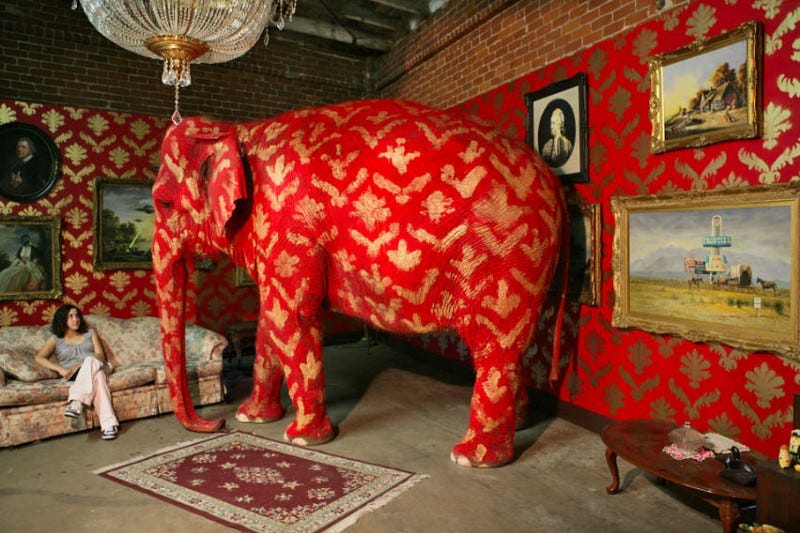
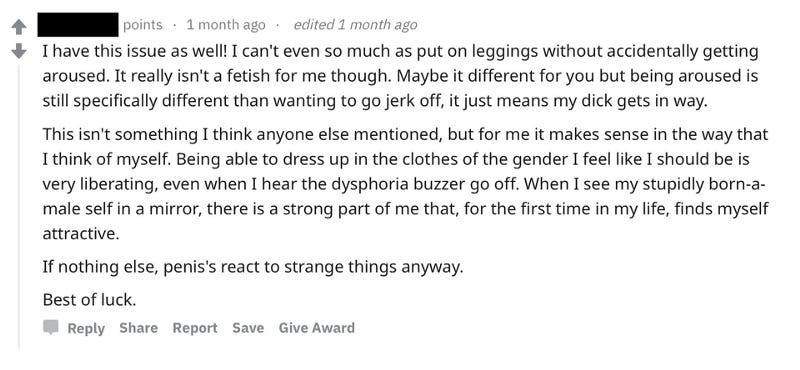
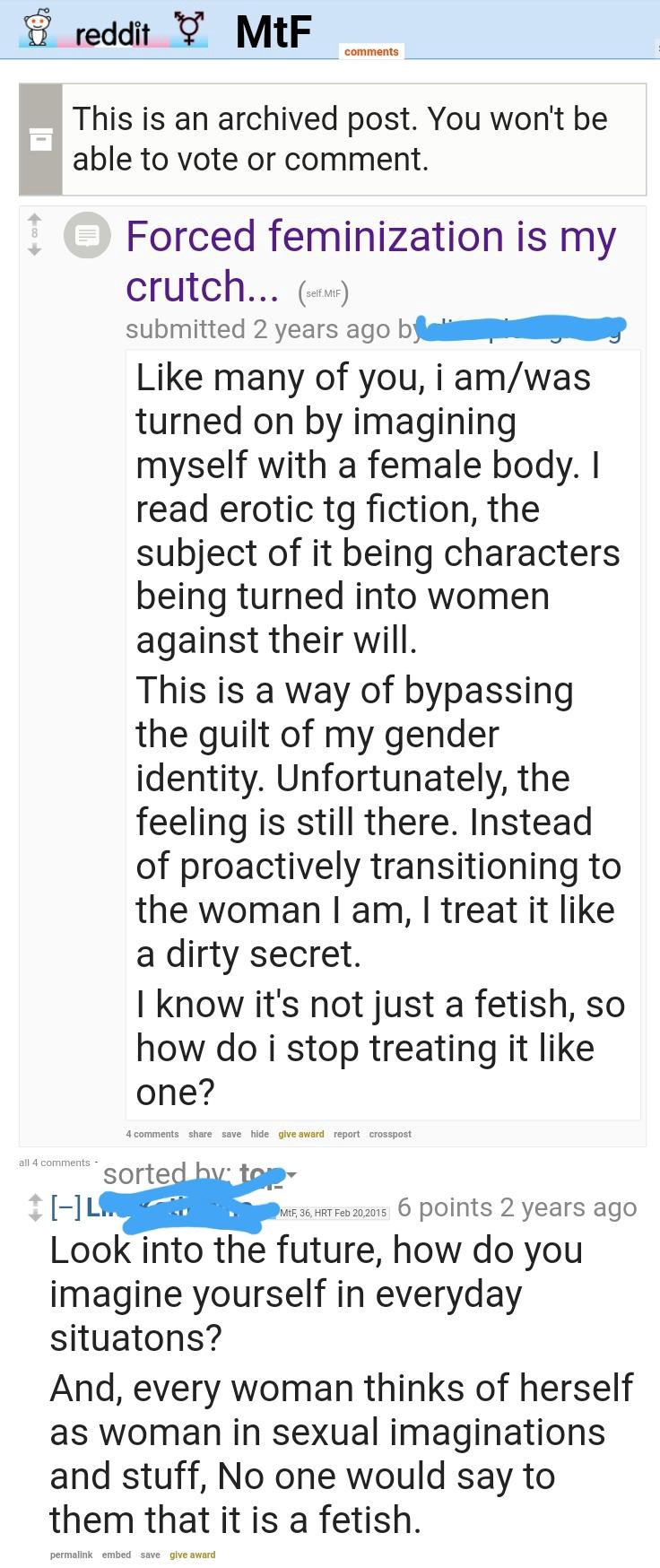

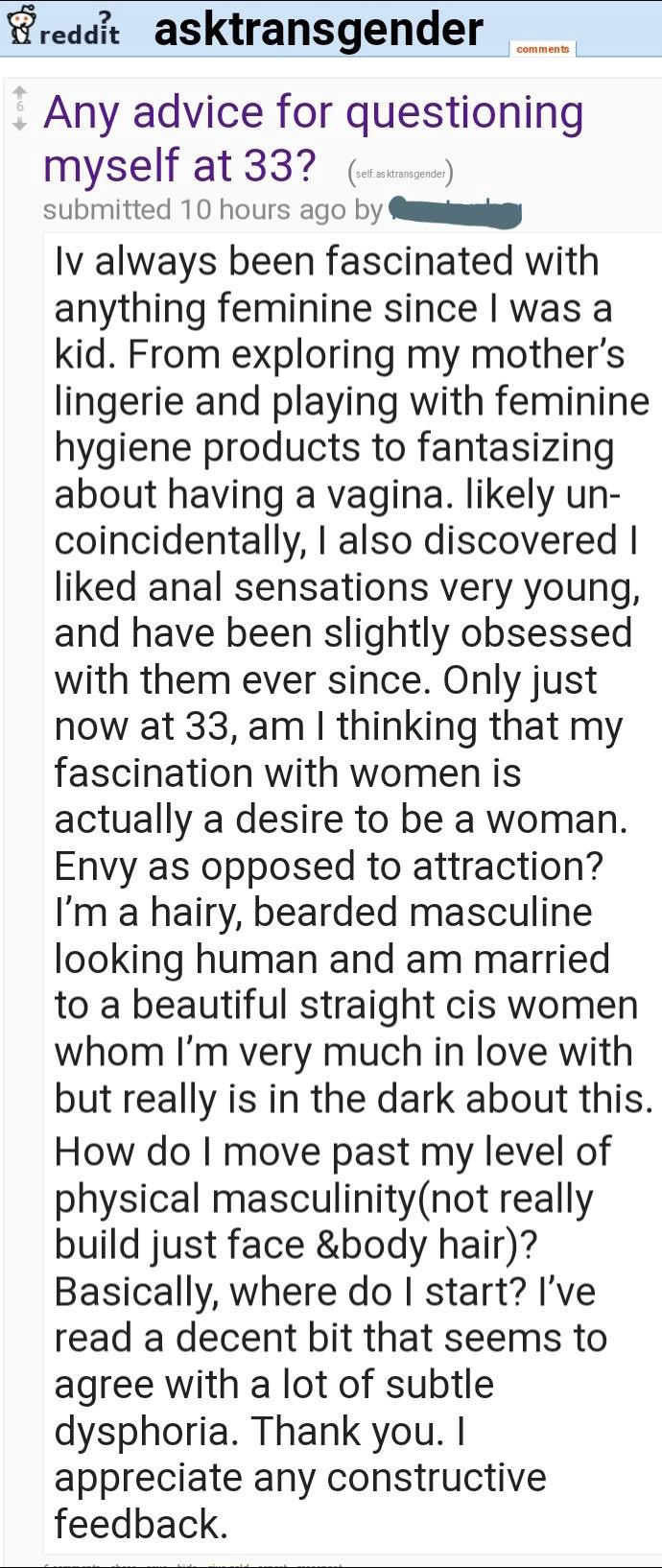
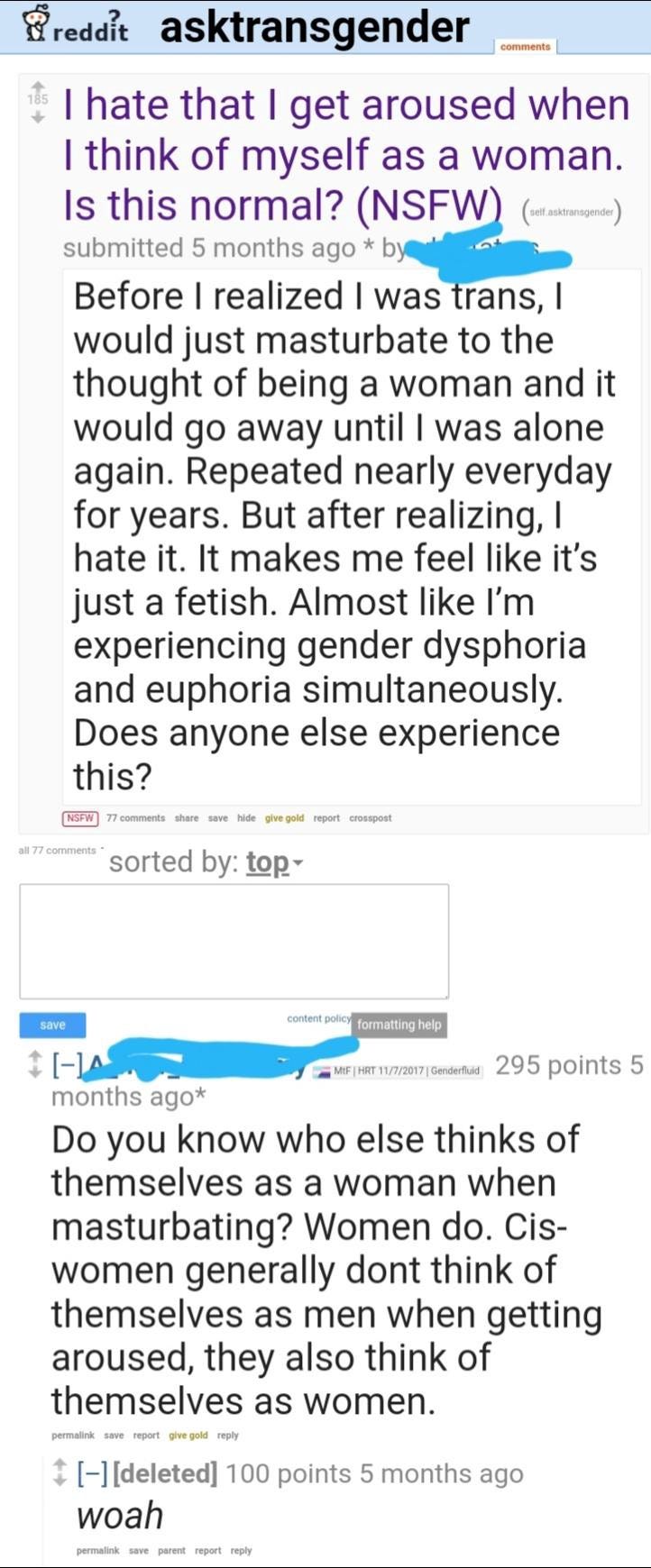
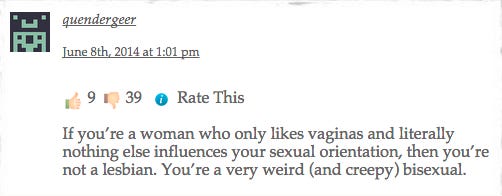


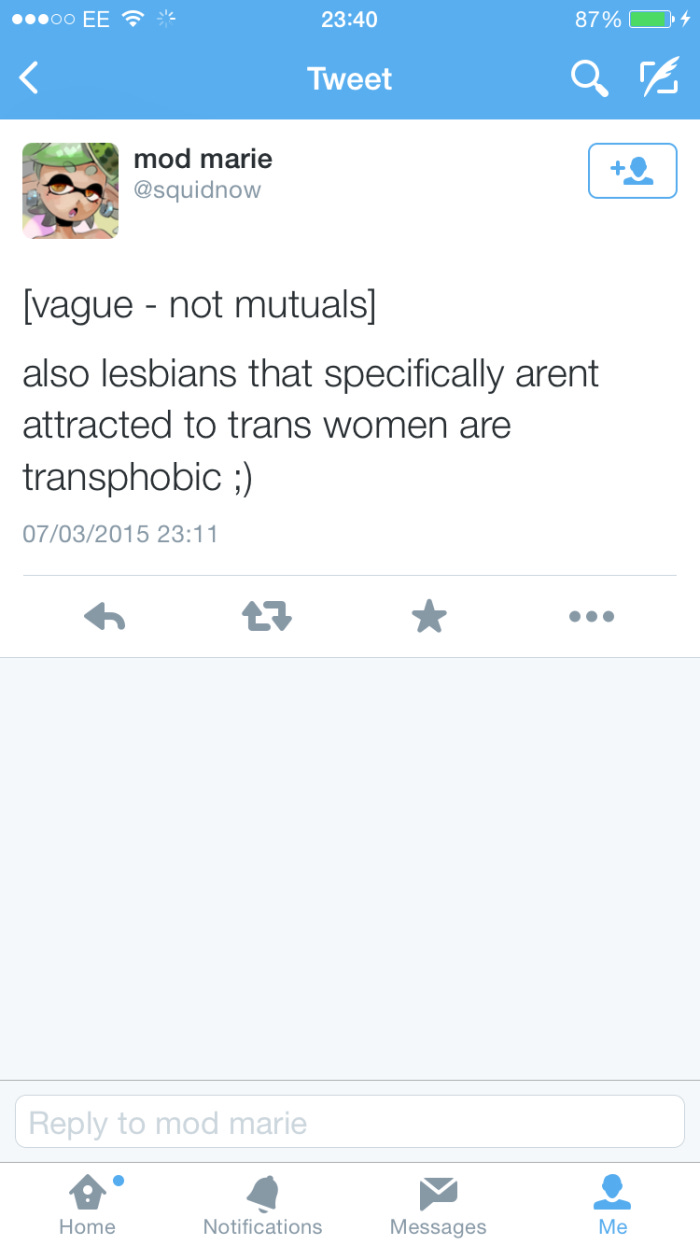
An excellent article. Indulge me as I reminisce my youth in and around a very vibrant gay community way back in the late 1970s and 1980s. The gay community (which was the label back then for *both* homosexual men and women) was becoming politically powerful, mainly due to the horror of the AIDS epidemic. First they demanded “tolerance”, which most straights were down with - it wasn’t long before tolerance and acceptance became more the norm than the exception. However, tolerance wasn’t enough. Communities which had long felt marginalized wanted more than tolerance. They wanted celebration. A straight who merely tolerated must now cheer and support and embrace. And all organizations which were viewed as straight were suddenly ripe for colonization. Resistance was lambasted as “homophobia” and in many cases, brought to court and prosecuted. Many such colonized organizations were transformed into nonexistence - destroyed. Soon, even bringing up and questioning the wisdom of this process was dangerous to the person who wanted to discuss the elephant in the room. This was all seen as “progress”.
Now that you’ve read this little history, re-read the article and try to spot the irony.
What a superb article! Please keep writing!